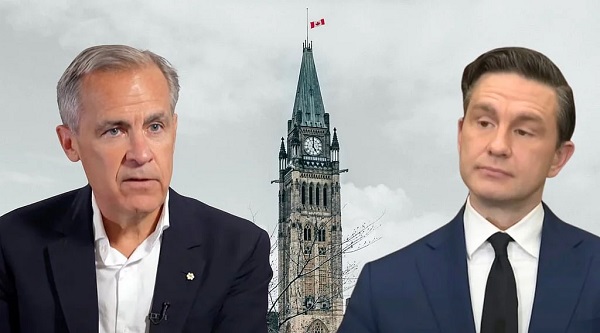Business
More government interventions hamper capitalism

From the Fraser Institute
By Philip Cross
In his fourth book, What Went Wrong With Capitalism, investor and author Ruchir Sharma eloquently details how advanced market economies for decades have increasingly strayed from the basic principles of market-based competition and pricing, resulting in persistently slow growth which causes many to question whether capitalism works anymore. However, what is often attributed to market failure is often a failure of government.
Collectivists have successfully installed the narrative that the Reagan and Thatcher era in the 1980s ushered in an era of neoliberalism and government austerity. Nothing could be further from the truth. Keynesian counter-cyclical government spending was supposed to support the economy during a recession; instead, it is used to support the economy at every point of the business cycle. At most, the Reagan and Thatcher regimes only slowed the rate of increase of government spending. Combined with a growing public resistance to paying higher taxes, this created permanent budget deficits. Policymakers remain stuck on the stimulus treadmill: former European Central Bank head Mario Draghi recently recommended the EU spend an inconceivable US$900 billion a year to revive its flagging economy.
Moreover, the slowdown in the growth of government spending did little to stop a tidal wave of government rules and regulations, many of which favour entrenched interests and firms. Sharma’s observation that being “pro-business is not the same as pro-capitalism, and the distinction continues to elude us” is especially true for Canada. He documents the increasing use of government subsidies and bail-outs, which helps fuel the growth of so-called zombie firms—unprofitable companies that stay in business thanks to support from governments or lending institutions (who know problems caused by bad loans will be bailed out by government), which prevent labour and capital from moving to areas with better long-term growth potential. Most recently, we have seen governments embrace higher tariffs and industrial policy, notably for green energy projects in Canada and the United States.
Increased government meddling in the marketplace reduces competition and slows the process of creative destruction that is the lifeblood of capitalism by allowing “new firms to rise up and destroy the complacent ones, making the economy ever more productive over time,” according to Sharma. This was most evident during the pandemic, when business failures declined as government hand-outs outweighed the impact of unprecedented shutdown of large parts of the economy. But the decline in business startups and failures has persisted for decades.
Steadily rising government intervention in the economy results in lower productivity and slower growth. This pushes policymakers to resort to higher fiscal deficits and easy money policies in a forlorn attempt to boost long-term potential growth.
It is often said that the recent slowdown of productivity reflects a lack of business investment. That is certainly part of the problem outside of the U.S., especially for Canada over the past decade. However, Sharma notes it is the efficiency and not just the level of investment that is the problem. Pervasive government interventions in the economy distort prices and the allocation of capital, resulting in what the libertarian economist Friedrich Hayek called “malinvestments.” This is especially true for Canada, which for over a decade has shunned clearly profitable investment opportunities in the resource sector while pouring tens of billions into expensive public transit systems, which nevertheless failed to persuade commuters to leave their vehicles at home.
One theme Sharma does not develop is that this growing inability of governments to efficiently deliver results is not due to a lack of resources. Governments have expanded their workforce, their spending, and their regulatory power. Nevertheless, government programs falter because of bad management, chronic political meddling for short-term electoral gains, and a workforce which increasingly serves its own interests and not public’s.
Sharma concludes on both an optimistic and pessimistic note. He examines the ability of capitalism to thrive in countries such as Switzerland and Taiwan by balancing “a business-friendly environment alongside social equality.” Nevertheless, he’s concerned with the “supreme irony: modern voters, particularly the young, now demand that leaders show respect for the fragility of natural ecosystems… [but] at the same time, leaders are riding a popular wave when they propose to intervene in the economy—the global ecosystem in which 8 billion people do business.”
As disillusionment with capitalism spreads due to slow growth, the temptation is to increase government interventions, which only worse the economic outcome.
Author:
Business
New airline compensation rules could threaten regional travel and push up ticket prices

New passenger compensation rules under review could end up harming passengers as well as the country’s aviation sector by forcing airlines to pay for delays and cancellations beyond their control, warns a new report published this morning by the MEI.
“Air travel in Canada is already unaffordable and inaccessible,” says Gabriel Giguère, senior public policy analyst at the MEI. “New rules that force airlines to cover costs they can’t control would only make a bad situation worse.”
Introduced in 2023 by then-Transport Minister Omar Alghabra, the proposed amendment to the Air Passenger Protection Regulations would make airlines liable for compensation in all cases except those deemed “exceptional.” Under the current rules, compensation applies only when the airline is directly responsible for the disruption.
If adopted, the new framework would require Canadian airlines to pay at least $400 per passenger for any “unexceptional” cancellation or delay exceeding three hours, regardless of fault. Moreover, the definition of “exceptional circumstances” remains vague and incomplete, creating regulatory uncertainty.
“A presumed-guilty approach could upend airline operations,” notes Mr. Giguère. “Reversing the burden of proof introduces another layer of bureaucracy and litigation, which are costs that will inevitably be passed on to consumers.”
The Canadian Transportation Agency estimates that these changes would impose over $512 million in additional costs on the industry over ten years, leading to higher ticket prices and potentially reducing regional air service.
Canadians already pay some of the highest airfares in the world, largely due to government-imposed fees. Passengers directly cover the Air Travellers Security Charge—$9.94 per domestic flight and $34.42 per international flight—and indirectly pay airport rent through Airport Improvement Fees included on every ticket.
In 2024 alone, airport authorities remitted a record $494.8 million in rent to the federal government, $75.6 million more than the previous year and 68 per cent higher than a decade earlier.
“This new regulation risks being the final blow to regional air travel,” warns Mr. Giguère. “Routes connecting smaller communities will be the first to disappear as costs rise and they become less profitable.”
For instance, a three-hour and one minute delay on a Montreal–Saguenay flight with 85 passengers would cost an airline roughly $33,000 in compensation. It would take approximately 61 incident-free return flights to recoup that cost.
Regional air service has already declined by 34 per cent since 2019, and the added burden of this proposed regulation could further reduce connectivity within Canada. It would also hurt Canadian airlines’ competitiveness relative to U.S. carriers operating out of airports just south of the border, whose passengers already enjoy lower fares.
“If the federal government truly wants to make air travel more affordable,” says Mr. Giguère, “it should start by cutting its own excessive fees instead of scapegoating airlines for political gain.”
You can read the Economic Note here.
* * *
The MEI is an independent public policy think tank with offices in Montreal, Ottawa, and Calgary. Through its publications, media appearances, and advisory services to policymakers, the MEI stimulates public policy debate and reforms based on sound economics and entrepreneurship.
Business
Will the Port of Churchill ever cease to be a dream?

From Resource Works
The Port of Churchill has long been viewed as Canada’s northern gateway to global markets, but decades of under-investment have held it back.
A national dream that never materialised
For nearly a century, Churchill, Manitoba has loomed in the national imagination. In 1931, crowds on the rocky shore watched the first steamships pull into Canada’s new deepwater Arctic port, hailed as the “thriving seaport of the Prairies” that would bring western grain “1,000 miles nearer” to European markets. The dream was that this Hudson Bay town would become a great Canadian centre of trade and commerce.
The Hudson Bay Railway was blasted across muskeg and permafrost to reach what engineers called an “incomparably superior” harbour. But a short ice free season and high costs meant Churchill never grew beyond a niche outlet beside Canada’s larger ports, and the town’s population shrank.
False starts, failed investments
In 1997, Denver based OmniTrax bought the port and 900 kilometre rail line with federal backing and promises of heavy investment. Former employees and federal records later suggested those promises were not fully kept, even as Ottawa poured money into the route and subsidies were offered to keep grain moving north. After port fees jumped and the Canadian Wheat Board disappeared, grain volumes collapsed and the port shut, cutting rail service and leaving northern communities and miners scrambling.
A new Indigenous-led revival — with limits
The current revival looks different. The port and railway are now owned by Arctic Gateway Group, a partnership of First Nations and northern municipalities that stepped in after washouts closed the line and OmniTrax walked away. Manitoba and Ottawa have committed $262.5 million over five years to stabilize the railway and upgrade the terminal, with Manitoba’s share now at $87.5 million after a new $51 million provincial pledge.
Prime Minister Mark Carney has folded Churchill into his wider push on “nation building” infrastructure. His government’s new Major Projects Office is advancing energy, mining and transmission proposals that Ottawa says add up to more than $116 billion in investment. Against that backdrop, Churchill’s slice looks modest, a necessary repair rather than a defining project.
The paperwork drives home the point. The first waves of formally fast tracked projects include LNG expansion at Kitimat, new nuclear at Darlington and copper and nickel mines. Churchill sits instead on the office’s list of “transformative strategies”, a roster of big ideas still awaiting detailed plans and costings, with a formal Port of Churchill Plus strategy not expected until the spring of 2026 under federal–provincial timelines.
Churchill as priority — or afterthought?
Premier Wab Kinew rejects the notion that Churchill is an afterthought. Standing with Carney in Winnipeg, he called the northern expansion “a major priority” for Manitoba and cast the project as a way for the province “to be able to play a role in building up Canada’s economy for the next stage of us pushing back against” U.S. protectionism. He has also cautioned that “when we’re thinking about a major piece of infrastructure, realistically, a five to 10 year timeline is probably realistic.”
On paper, the Port of Churchill Plus concept is sweeping. The project description calls for an upgraded railway, an all weather road, new icebreaking capacity in Hudson Bay and a northern “energy corridor” that could one day move liquefied natural gas, crude oil, electricity or hydrogen. Ottawa’s joint statement with Manitoba calls Churchill “without question, a core component to the prosperity of the country.”
Concepts without commitments
The vision is sweeping, yet most of this remains conceptual. Analysts note that hard questions about routing, engineering, environmental impacts and commercial demand still have to be answered. Transportation experts say they struggle to see a purely commercial case that would make Churchill more attractive than larger ports, arguing its real value is as an insurance policy for sovereignty and supply chain resilience.
That insurance argument is compelling in an era of geopolitical risk and heightened concern about Arctic security. It is also a reminder of how limited Canada’s ambition at Churchill has been. For a hundred years, governments have been willing to dream big in northern Manitoba, then content to underbuild and underdeliver, as the port’s own history of near misses shows. A port that should be a symbol of confidence in the North has spent most of its life as a seasonal outlet.
A Canadian pattern — high ambition, slow execution
The pattern is familiar across the country. Despite abundant resources, capital and engineering talent, mines, pipelines, ports and power lines take years longer to approve and build here than in competing jurisdictions. A tangle of overlapping regulations, court challenges and political caution has turned review into a slow moving veto, leaving a politics of grand announcements followed by small, incremental steps.
Churchill is where those national habits are most exposed. The latest round of investment, led by Indigenous owners and backed by both levels of government, deserves support, as does Kinew’s insistence that Churchill is a priority. But until Canada matches its Arctic trading rhetoric with a willingness to build at scale and at speed, the port will remain a powerful dream that never quite becomes a real gateway to the world.
Headline photo credit to THE CANADIAN PRESS/John Woods
-

 Health2 days ago
Health2 days agoCDC’s Autism Reversal: Inside the Collapse of a 25‑Year Public Health Narrative
-

 Crime2 days ago
Crime2 days agoCocaine, Manhunts, and Murder: Canadian Cartel Kingpin Prosecuted In US
-

 Health2 days ago
Health2 days agoBREAKING: CDC quietly rewrites its vaccine–autism guidance
-

 National2 days ago
National2 days agoPsyop-Style Campaign That Delivered Mark Carney’s Win May Extend Into Floor-Crossing Gambits and Shape China–Canada–US–Mexico Relations
-

 Energy2 days ago
Energy2 days agoHere’s what they don’t tell you about BC’s tanker ban
-

 Daily Caller2 days ago
Daily Caller2 days agoBREAKING: Globalist Climate Conference Bursts Into Flames
-

 Bruce Dowbiggin2 days ago
Bruce Dowbiggin2 days agoBurying Poilievre Is Job One In Carney’s Ottawa
-

 Great Reset1 day ago
Great Reset1 day agoEXCLUSIVE: A Provincial RCMP Veterans’ Association IS TARGETING VETERANS with Euthanasia








